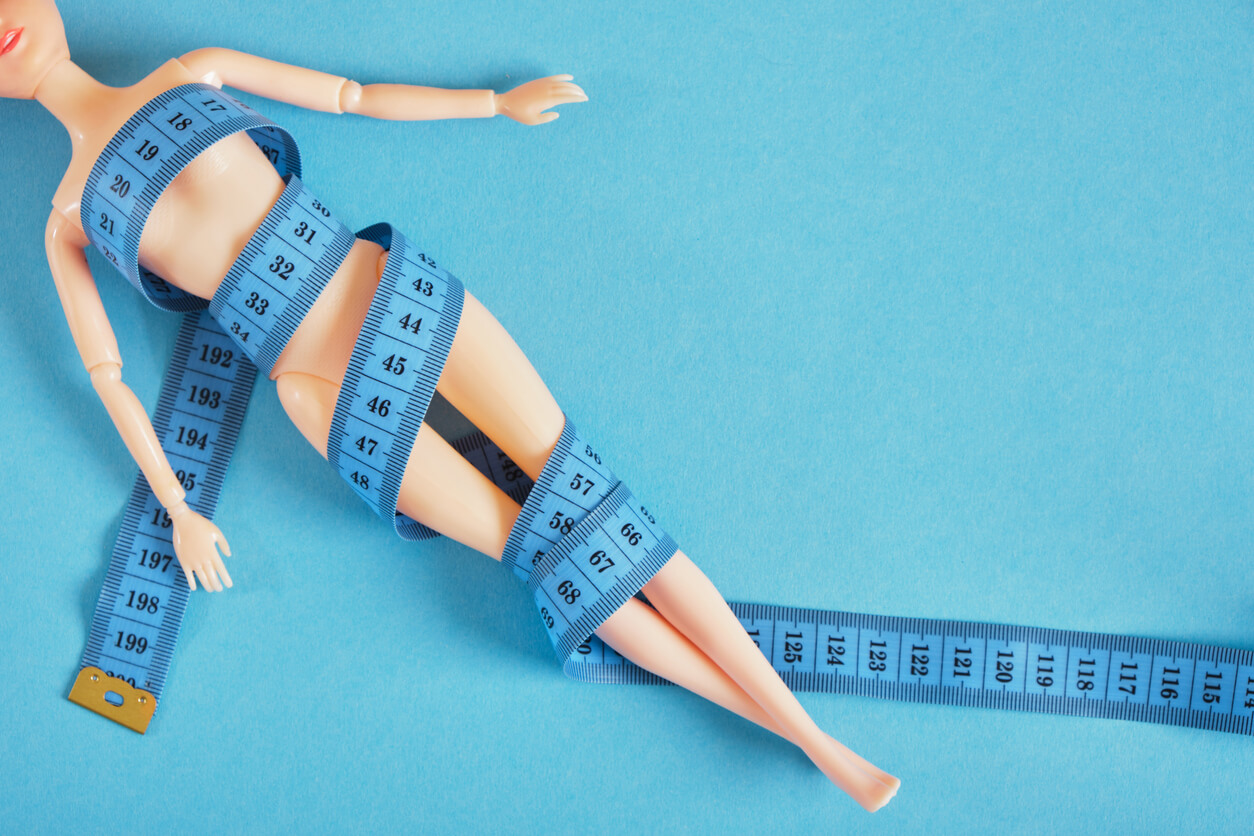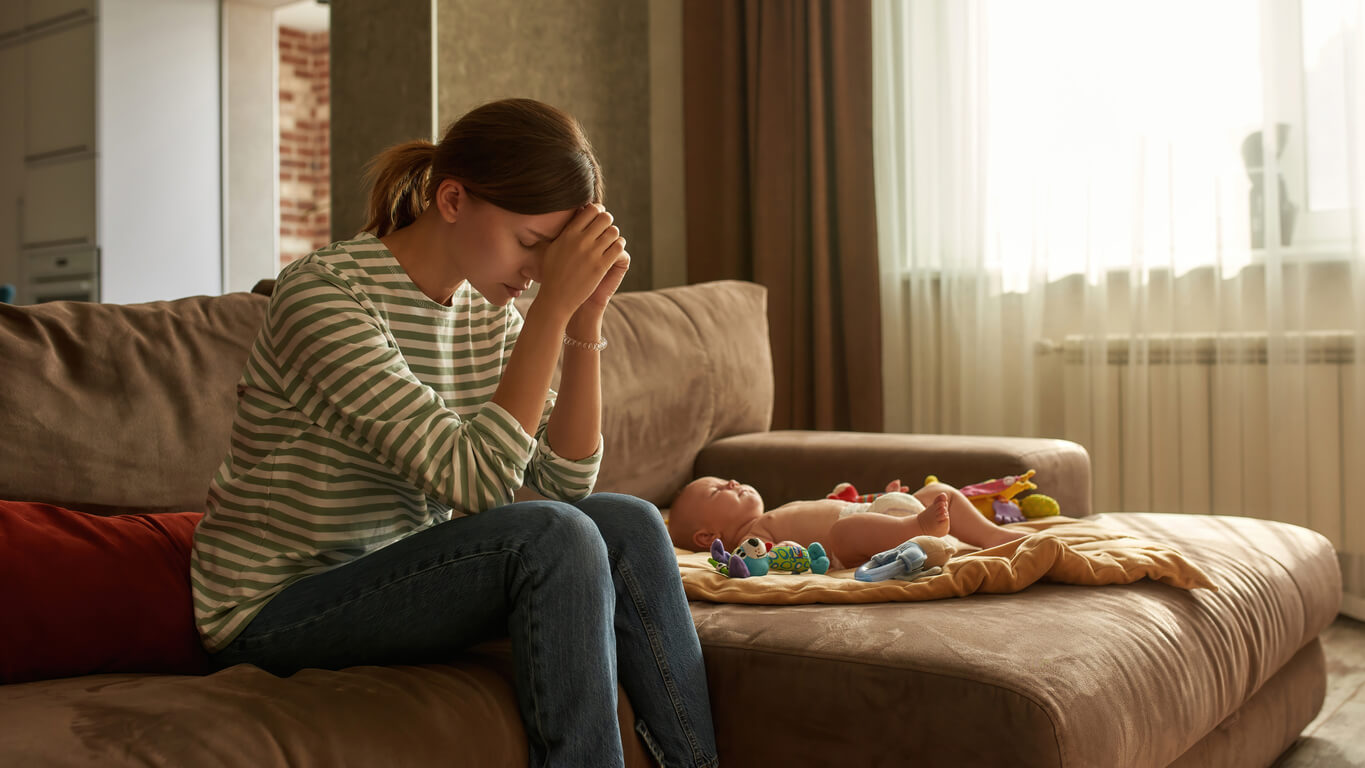Anorexia and Bulimia After Childbirth

Eating disorders (ED) have generally been associated with adolescents, as it’s at this stage of life that they appear most frequently. However, cases of anorexia and bulimia after childbirth are increasingly frequent and alert us to a risky problem for the health of mothers and children.
The postpartum period is a particularly vulnerable period on an emotional level, as the new mother has to face physical, hormonal, bonding, and daily routine changes. And all these issues together aren’t always easy to manage. In this context, the fears of motherhood and concern about weight and body image can trigger or aggravate some disorders, such as anorexia and bulimia.
Find out everything you need to know about them to avoid overlooking important warning signs. Keep reading!
Anorexia and bulimia after giving birth: How do they manifest themselves?
In both anorexia and bulimia, there’s an excessive preoccupation with weight and body image. There’s even a marked distortion of the perception of one’s own body, which leads to seeing oneself as worse than others see one’s body.
Physical appearance is closely linked to a woman’s self-evaluation and her own perception of value. As a result of the discomfort generated by appearance, different maladaptive behaviors are set in motion, derived from an intense fear of gaining weight.
Despite sharing a central element common to both conditions, these disorders are different. And we’ll explain their distinctive features below.
You may be interested in: What Is Pregorexia? Symptoms and Consequences
Anorexia nervosa

Anorexia is characterized by a voluntary restriction of food intake, which leads to the person not meeting their daily nutritional and energy requirements. As a result, they maintain a body weight that’s significantly lower than what would be considered healthy for them.
Despite being underweight, the person with anorexia doesn’t recognize the presence of the disorder or the severity of their situation. They even maintain those behaviors that prevent weight gain, which are usually of a restrictive nature. For example, adherence to severe diets, fasting, or excessive physical exercise. In addition to this, binge eating followed by purging behaviors aimed at compensating can also be included.
Bulimia after childbirth
In the case of bulimia, the typical behavior pattern is characterized by binge eating followed by compensatory behaviors. The former consist of an intake of excessive amounts of food in a period of less than two hours. During this time, the person eats compulsively and uncontrollably, until they feel uncomfortably full. Then, they experience great guilt and shame for what happened.
Such binge eating occurs at least once a week, for at least three consecutive months. And they’re followed by behaviors aimed at preventing weight gain, such as self-induced vomiting, excessive exercise routines, or inappropriate use of laxatives and diuretics.
Why do anorexia and bulimia after childbirth occur?
There are several reasons why anorexia and bulimia occur after childbirth.
The physical changes that a woman’s body undergoes during pregnancy and the postpartum period are the main causes. After childbirth, the body needs a variable recovery time before returning to its original state (something that doesn’t always happen completely).
The new mother already has her baby in her arms, but she still sees a deformed silhouette in her body. This can cause anguish and concern, especially because of the social pressure on women to regain their figure as soon as possible. Also, due to the lack of understanding of the postpartum period and its processes.
As if this weren’t enough, women who have just given birth face a series of fears, responsibilities, and uncertainties derived from motherhood. Their identity is completely transformed by their new role as a mother, and they may become overly concerned about the baby’s well-being, how well they will do as a mother, and how their life will change.
Sometimes this feeling of lack of control leads to the development of an eating disorder.
Finally, anorexia and bulimia after childbirth are associated with the presence of postpartum depression. This condition increases the discomfort, pressures, and guilt felt by the woman in this vulnerable period of her life. All these issues make her more likely to feel dissatisfied with her new situation.

The consequences and prevention of anorexia and bulimia after childbirth
Postpartum eating disorders not only affect the health and well-being of women, but also that of their children. Many mothers choose to stop breastfeeding earlier than recommended in order to go on a diet. Others simply don’t have sufficient milk production for the same reason.
On the other extreme, there are women who offer the breast to the baby excessively in order to expend more calories and avoid weight gain. Also, it’s common for these women to project their feeding difficulties onto their children, either by overfeeding or by fear of perceiving them as “fat”.
In addition, we can’t forget that a woman who doesn’t feel well or who’s going through an illness isn’t in the best condition to offer her child the nurturing she needs. She may experience difficulties in bonding with the child and in accepting her role as a mother. She may also face feelings of anxiety, discomfort, and guilt that don’t allow her to provide the best care.
Therefore, it’s essential that there are resources to help new mothers in this regard. An ED can emerge in the postpartum period in women who have never had similar problems or can worsen in existing cases.
It’s important for professionals, the environment, and mothers themselves to be aware of possible behaviors and symptoms that may be warning signs. In this way, the necessary support can be provided at this time to manage the incipient or already established disorder.
Eating disorders (ED) have generally been associated with adolescents, as it’s at this stage of life that they appear most frequently. However, cases of anorexia and bulimia after childbirth are increasingly frequent and alert us to a risky problem for the health of mothers and children.
The postpartum period is a particularly vulnerable period on an emotional level, as the new mother has to face physical, hormonal, bonding, and daily routine changes. And all these issues together aren’t always easy to manage. In this context, the fears of motherhood and concern about weight and body image can trigger or aggravate some disorders, such as anorexia and bulimia.
Find out everything you need to know about them to avoid overlooking important warning signs. Keep reading!
Anorexia and bulimia after giving birth: How do they manifest themselves?
In both anorexia and bulimia, there’s an excessive preoccupation with weight and body image. There’s even a marked distortion of the perception of one’s own body, which leads to seeing oneself as worse than others see one’s body.
Physical appearance is closely linked to a woman’s self-evaluation and her own perception of value. As a result of the discomfort generated by appearance, different maladaptive behaviors are set in motion, derived from an intense fear of gaining weight.
Despite sharing a central element common to both conditions, these disorders are different. And we’ll explain their distinctive features below.
You may be interested in: What Is Pregorexia? Symptoms and Consequences
Anorexia nervosa

Anorexia is characterized by a voluntary restriction of food intake, which leads to the person not meeting their daily nutritional and energy requirements. As a result, they maintain a body weight that’s significantly lower than what would be considered healthy for them.
Despite being underweight, the person with anorexia doesn’t recognize the presence of the disorder or the severity of their situation. They even maintain those behaviors that prevent weight gain, which are usually of a restrictive nature. For example, adherence to severe diets, fasting, or excessive physical exercise. In addition to this, binge eating followed by purging behaviors aimed at compensating can also be included.
Bulimia after childbirth
In the case of bulimia, the typical behavior pattern is characterized by binge eating followed by compensatory behaviors. The former consist of an intake of excessive amounts of food in a period of less than two hours. During this time, the person eats compulsively and uncontrollably, until they feel uncomfortably full. Then, they experience great guilt and shame for what happened.
Such binge eating occurs at least once a week, for at least three consecutive months. And they’re followed by behaviors aimed at preventing weight gain, such as self-induced vomiting, excessive exercise routines, or inappropriate use of laxatives and diuretics.
Why do anorexia and bulimia after childbirth occur?
There are several reasons why anorexia and bulimia occur after childbirth.
The physical changes that a woman’s body undergoes during pregnancy and the postpartum period are the main causes. After childbirth, the body needs a variable recovery time before returning to its original state (something that doesn’t always happen completely).
The new mother already has her baby in her arms, but she still sees a deformed silhouette in her body. This can cause anguish and concern, especially because of the social pressure on women to regain their figure as soon as possible. Also, due to the lack of understanding of the postpartum period and its processes.
As if this weren’t enough, women who have just given birth face a series of fears, responsibilities, and uncertainties derived from motherhood. Their identity is completely transformed by their new role as a mother, and they may become overly concerned about the baby’s well-being, how well they will do as a mother, and how their life will change.
Sometimes this feeling of lack of control leads to the development of an eating disorder.
Finally, anorexia and bulimia after childbirth are associated with the presence of postpartum depression. This condition increases the discomfort, pressures, and guilt felt by the woman in this vulnerable period of her life. All these issues make her more likely to feel dissatisfied with her new situation.

The consequences and prevention of anorexia and bulimia after childbirth
Postpartum eating disorders not only affect the health and well-being of women, but also that of their children. Many mothers choose to stop breastfeeding earlier than recommended in order to go on a diet. Others simply don’t have sufficient milk production for the same reason.
On the other extreme, there are women who offer the breast to the baby excessively in order to expend more calories and avoid weight gain. Also, it’s common for these women to project their feeding difficulties onto their children, either by overfeeding or by fear of perceiving them as “fat”.
In addition, we can’t forget that a woman who doesn’t feel well or who’s going through an illness isn’t in the best condition to offer her child the nurturing she needs. She may experience difficulties in bonding with the child and in accepting her role as a mother. She may also face feelings of anxiety, discomfort, and guilt that don’t allow her to provide the best care.
Therefore, it’s essential that there are resources to help new mothers in this regard. An ED can emerge in the postpartum period in women who have never had similar problems or can worsen in existing cases.
It’s important for professionals, the environment, and mothers themselves to be aware of possible behaviors and symptoms that may be warning signs. In this way, the necessary support can be provided at this time to manage the incipient or already established disorder.
All cited sources were thoroughly reviewed by our team to ensure their quality, reliability, currency, and validity. The bibliography of this article was considered reliable and of academic or scientific accuracy.
- Behar Astudillo, R. (2013). Trastornos de la conducta alimentaria, embarazo y puerperio. Medicas UIS, 26(1), 21-28.
- The National Eating Disorders Collaboration. (2015). Pregnancy and Eating Disorders: A Professional’s Guide to Assessment and Referral. https://nedc.com.au/assets/NEDC-Resources/NEDC-Resource-Pregnancy.pdf
This text is provided for informational purposes only and does not replace consultation with a professional. If in doubt, consult your specialist.








